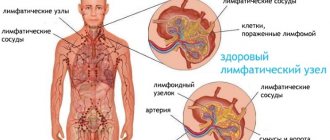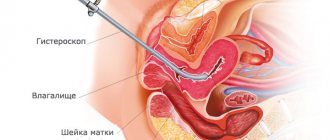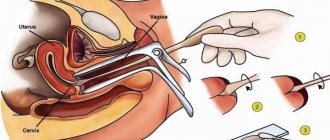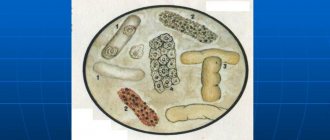FVD - what is it?
FVD is an abbreviation that stands for “function of external respiration.” This study allows you to evaluate the functioning of the respiratory system. For example, with its help, the doctor determines how much air enters the patient’s lungs and how much comes out. In addition, during the test, changes in air flow speed in different parts of the respiratory system can be analyzed. Thus, the study helps to assess the ventilation abilities of the lungs.
Spirometry
The study determines the actual vital capacity, which is compared with the expected vital capacity (VC). In an adult of average height, the BEL is 3-5 liters. In men, its value is approximately 15% greater than in women. Schoolchildren aged 11-12 years have a VAL of about 2 liters; children under 4 years old – 1 liter; newborns – 150 ml. VIT=DO+ROVD+ROVD. VC can be calculated using the formula: VC (l) = 2.5×height (m).
○ Tidal volume (TV), or depth of breathing, is the volume of air inhaled and exhaled at rest.
In adults, DO = 400-500 ml, in children 11-12 years old - about 200 ml, in newborns - 20-30 ml.
○ Expiratory reserve volume (ERV) – the maximum volume that can be exhaled with effort after a quiet exhalation. ROvyd = 800-1500 ml.
○ Inspiratory reserve volume (IRV) – the maximum volume of air that can be additionally inhaled after a quiet inhalation.
Inspiratory reserve volume can be determined in two ways: calculated or measured with a spirometer. To calculate, it is necessary to subtract the sum of the respiratory and expiratory reserve volumes from the vital capacity value. To determine the inspiratory reserve volume using a spirometer, you need to fill the spirometer with 4 to 6 liters of air and, after a quiet inhalation from the atmosphere, take a maximum breath from the spirometer. The difference between the initial volume of air in the spirometer and the volume remaining in the spirometer after a deep inspiration corresponds to the inspiratory reserve volume.
ROVD =1500-2000 ml.
○ Residual volume (VR )
- the volume of air remaining in the lungs even after maximum exhalation. Measured only by indirect methods. The principle of one of them is that a foreign gas such as helium is injected into the lungs (dilution method) and the volume of the lungs is calculated by changing its concentration. The residual volume is 25-30% of the vital capacity.
Take OO=500-1000 ml.
○ Total lung capacity (TLC) - the amount of air in the lungs after maximum inspiration. OEL=VEL+OO. TEL = 4500-7000 ml.
○ Functional residual lung capacity (FOLC) - the amount of air remaining in the lungs after a quiet exhalation. FOEL=ROVD.
○ Inspiratory capacity (IUC) – the maximum volume of air that can be inhaled after a quiet exhalation. EVD=DO+ROVD.
In addition to static indicators characterizing the degree of physical development of the respiratory apparatus, there are additional - dynamic indicators
, providing information about the effectiveness of pulmonary ventilation and the functional state of the respiratory tract.
○ Forced vital capacity (FVC) - the amount of air that can be exhaled during a forced exhalation after a maximum inspiration.
Normally, the difference between VC and FVC is 100-300 ml. An increase in this difference to 1500 ml or more indicates resistance to air flow due to narrowing of the lumen of the small bronchi. FVC = 3000-7000 ml.
○ Anatomical dead space (ADS) - the volume in which gas exchange does not occur (nasopharynx, trachea, large bronchi) - cannot be directly determined.
DMP = 150 ml.
○ Respiratory rate (RR) – the number of respiratory cycles in one minute. BH = 16-18 bpm/min.
○ Minute respiration volume (MRV) – the amount of air ventilated in the lungs in 1 minute. MOD = TO + BH. MOD = 8-12 l.
○ Alveolar ventilation (AV) - the volume of exhaled air entering the alveoli.
AB = 66 – 80% of mod. AB = 0.8 l/min.
○ Breathing reserve (RR) is an indicator characterizing the possibilities of increasing ventilation.
Normally, RD is 85% of maximum pulmonary ventilation (MVV). MVL = 70-100 l/min.
2. Spirography
Spirography is a method of graphically recording tidal volumes, which can be used to determine all of the above indicators of pulmonary ventilation.
Currently, electronic devices and computer programs are used that make it possible to graphically record and process the volumes, flows and speeds of respiratory maneuvers in a variety of modes.
3. Functional tests
The time during which a person can hold his breath, overcoming the desire to inhale, varies individually.
It depends on the excitability of the central nervous system, the state of the external respiratory apparatus, the cardiovascular system and the blood system. The duration of voluntary maximum breath holding is used as a functional test that characterizes several body systems. As is known, the main stimulant of respiration is carbon dioxide. In healthy people, the time of maximum breath holding after a deep (but not maximum) inspiration ( Stange test
) is 40-60 seconds, after a calm exhalation (
Genche test
) it is less than 30-40 seconds.
These indicators change with forced breathing.
The importance of FVD for modern medicine
In fact, the significance of this study is difficult to overestimate. Naturally, it is used to diagnose certain disorders of the respiratory system. But the range of application of the method is much wider. For example, spirometry is a mandatory, routine test for people working in hazardous environments. In addition, the results of this analysis are used for expert assessment of a person’s performance, determining his suitability for work in certain environmental conditions.
The study is used for dynamic observation, as it makes it possible to assess the rate of development of a particular disease, as well as the results of therapy. In some cases, FVD analysis is used to diagnose allergic diseases, because it allows one to trace the effect of a particular substance on the respiratory tract. In some cases, mass spirometry of the population is carried out to determine the health status of residents of certain geographical or environmental zones.
Role in diagnosis
Spirography for bronchial asthma has its own characteristics both in the methodology and in the interpretation of the results.
An important role for diagnosing this disease is played by the forced inhalation and exhalation test, on the basis of which a graph is automatically constructed in the form of a “volume-flow” loop. It is by its form that, in the presence of respiratory failure, its type is determined: restrictive (associated with organic damage to the lungs), obstructive (due to impaired air flow through the bronchial or alveolar tree) or mixed. Also, from the resulting curve, one can trace a decrease in the volumetric forced expiratory flow rate of peak and in the FVC range of 25-75%, as well as the volume of forced inspiration. This visually demonstrates the pathogenesis of asthma, in which sudden spasm of the distal bronchi occurs, which is manifested by attacks of suffocation.
Indications for analysis
So, the study is recommended for patients with suspected bronchial asthma, chronic bronchitis or any other chronic disease of the bronchopulmonary system. Indications for analysis are also chronic cough and frequent attacks of shortness of breath. In addition, the study is used to diagnose lesions of the pulmonary vessels, including pulmonary artery thrombosis, pulmonary hypertension, etc. The results of pulmonary hypertension are also important for the correct treatment of some thoraco-diaphragmatic disorders, including obesity, accompanied by alveolar hypoventilation, as well as pleural moorings, various disorders posture and curvature of the spine, neuromuscular paralysis. In some cases, the analysis is prescribed to patients in order to assess the effectiveness of the chosen treatment regimen.
When is lung spirography necessary?
The corresponding examination is widely used in pulmonology to assess the condition of patients. There is no need to use the technique in people with seasonal colds or short-term cough.
Situations in which spirography is used:
- discomfort inside the chest, characterized by a long course;
- cough that does not respond to traditional drug treatment for a month or more;
- often recurrent bronchitis and pneumonia;
- monitoring the quality of treatment of bronchial asthma;
- constant contact with polluted air (work in a mine, chemical plant);
- genetic predisposition to respiratory tract disorders;
- long history of smoking.
Spirography allows you to evaluate lung function. By analyzing the final data obtained after the study, it is possible to establish the type and severity of respiratory failure (RF).
There are 3 options for the development of pathology:
- Obstructive type, caused by excessive spasm of the airways, which is accompanied by difficulty in exhaling. Chronic bronchitis is a typical representative of diseases with the indicated variant of DN;
- Restrictive type caused by impaired alveolar function. The latter lose their normal ability to expand, which limits the filling of the lungs with air;
- Mixed type, combining the characteristics of the two options described above.
Based on the results obtained, appropriate treatment is selected to influence specific parts of the pathological process.
How to properly prepare for research
In order to obtain the most accurate results, it is necessary to follow some recommendations before performing FVD. What are these preparation rules? In fact, everything is simple - you need to create conditions for maximum free breathing. Spirometry is usually performed on an empty stomach. If the test is scheduled for the afternoon or evening, then you can eat a light meal, but no later than two hours before the test. In addition, you should not smoke 4-6 hours before the examination. The same applies to physical activity - at least a day before FVD, the doctor recommends limiting physical activity, canceling workouts or morning jogging, etc. Some medications may also affect the results of the study. Therefore, on the day of the procedure, you should not take medications that can affect airway resistance, including medications from the group of non-selective beta blockers and bronchodilators. In any case, be sure to tell your doctor what medications you are taking.
Conditions
So, we have understood the concept of “spirography”. How this research is carried out is also important to know. It is prescribed, as a rule, in the morning or afternoon, preferably on an empty stomach. However, it is also possible to carry it out after a light breakfast, provided that at least 2 hours have passed since the meal. First, so that the analysis indicators do not give false information, the patient is allowed to rest physically and emotionally for 15 minutes while sitting. During this time, the heart rate and respiratory movements should normalize, which means that the study will show the real picture of his health. It is also important that during the last 6-12 hours the patient does not take drugs with a bronchodilator effect.
Description of the procedure
The study takes no more than an hour. To begin, the doctor carefully measures the patient's height and weight. After this, the person being examined is put on a special clip on his nose - thus, he can only breathe through his mouth. The patient holds a special mouthpiece in his mouth through which he breathes - it is connected to a special sensor that records all indicators. First, the doctor monitors the normal breathing cycle. After this, the patient needs to perform a certain breathing maneuver - first take as deep a breath as possible, and then try to sharply exhale the maximum volume of air. This pattern needs to be repeated several times.
After about 15-20 minutes, the specialist can already give you the results of the physical examination. The norm here depends on many factors, including gender. For example, the total lung capacity in men is on average 6.4 liters, and in women - 4.9 liters. In any case, the results of the analysis will need to be shown to the doctor, since only he knows how to correctly interpret the FVD. Deciphering will be of great importance for drawing up a further treatment regimen.
Norms
| Main indicators of spirography | Norm |
| Forced expiratory volume in the first second (FEV1, FEV1) | > 80% |
| Forced vital capacity (FVC) | > 80% |
| Modified Tiffno index (FEV1/FVC) | > 75% |
| Average forced expiratory volumetric flow rate at 25–75% of FVC (SOS25–75%, FEV25–75%) | > 75% |
| Peak forced expiratory flow rate (PEF) | > 80% |
Additional Research
In the event that the classic spirometry scheme has shown the presence of certain abnormalities, some additional types of respiratory function can be carried out. What kind of tests are these? For example, if a patient has signs of some obstructive ventilation disorders, he is given a special drug from the group of bronchodilators before the study.
“FVD with a bronchodilator - what is it?” - you ask. It's simple: this medicine helps to expand the airways, after which the analysis is carried out again. This procedure makes it possible to assess the degree of reversibility of the detected violations. In some cases, the diffusion capacity of the lungs is also examined - such an analysis provides a fairly accurate assessment of the functioning of the alveolar-capillary membrane. Sometimes doctors also determine the strength of the respiratory muscles or the so-called airiness of the lungs.
Contraindications to performing FVD
Of course, this study has a number of contraindications, since not all patients can undergo it without harming their own health. Indeed, during various respiratory maneuvers, tension in the respiratory muscles, increased load on the osseous-ligamentous apparatus of the chest, as well as an increase in intracranial, intra-abdominal and intrathoracic pressure are observed.
Spirometry is contraindicated in patients who have previously undergone surgery, including ophthalmic surgery - in such cases you need to wait at least six weeks. Contraindications also include myocardial infarction, stroke, dissecting aneurysm and some other diseases of the circulatory system. The analysis is not carried out to assess the functioning of the respiratory system of children of primary preschool age and elderly people (over 75 years old). It is also not prescribed to patients with epilepsy, hearing impairment and mental disorders.
Characteristics of the spirograph
A modern spirometer is very compact (portable), easy to use, highly effective and informative. Thanks to the device, the main operating functions of the respiratory system can be determined and recorded. The received information is displayed on the display. In medical institutions, the equipment is used to monitor therapeutic manipulations in such areas as cardiology, allergology and pulmonology.
Pulmonary respiration occurs through several processes: the first is ventilation of the alveoli; the second is blood circulation; the third is metabolism. Using a spirograph, you can only examine the ventilation apparatus. This study is sufficient to identify disorders of the lungs and make a correct diagnosis. The spirometer is able to detect pulmonary insufficiency, which is caused by dysfunction of the alveoli, and also detect the presence of other serious diseases of the respiratory system.
Content:
- Characteristics of the spirograph
- The essence of spirography
- Preparing for diagnosis
- Conducting a test using a spirometer
- What does a spirograph measure?
Are there any possible side effects?
Many patients are interested in whether FVD analysis can cause any problems. What are these side effects? How dangerous can the procedure be? In fact, the study, provided all established rules are followed, is practically safe for the patient. Since in order to obtain accurate results, a person must repeat breathing maneuvers with forced exhalation several times during the procedure, slight weakness and dizziness may occur. Do not be alarmed, as these side effects disappear on their own after a few minutes. Some undesirable phenomena may appear during the analysis of the pH value of the sample. What are these symptoms? Bronchodilator drugs can cause mild tremors in the limbs and sometimes a rapid heartbeat. But, again, these disorders go away on their own immediately after the procedure is completed.
Diseases for which a doctor may prescribe spirography
Chronic obstructive pulmonary disease
Forced vital capacity (FVC) and modified Tiffno index (FEV1/FVC) decrease in COPD. Peak forced expiratory flow rate (PEF) (normally its value exceeds 80% of the expected value) is the main indicator of self-control in obstructive pulmonary diseases.
Acute obstructive bronchitis
Peak forced expiratory flow rate (PEF) (normally its value exceeds 80% of the expected value) is the main indicator of self-control in obstructive pulmonary diseases.
Goodpasture's syndrome
A decrease in vital capacity, FEV1, and Tiffno index is characteristic.










